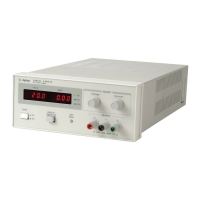A-8
Ammeter and CC Set Calibration
To calibrate ammeter and CC set, proceed as follows:
a. Connect test setup on Fi
ure A-9.
b. Turn VOLTAGE and CURRENT control full
clock-
wise.
c. Turn on the suppl
and to calibrate ammeter adjust
R5 on the displa
board until front panel AMPS dis-
pla
reads exactl
DVM value divided b
Rs.
d. To calibrate CC Set adjust R69 on the main board
until front panel AMPS displa
reads exactl
DVM
value divided b
Rs while depressin
OVP/CC Set
switch.
Voltmeter and OVP Set Calibration
To calibrate voltmeter and OVP set, proceed as follows:
a. Disconnect Rs from test setup on Fi
ure A-9 and
connect DVM across output terminal of the suppl
.
b. Turn on the suppl
.
c. To calibrate voltmeter for E3614A, adjust R16 on the
displa
board until front panel VOLTS displa
reads
exactl
DVM value. To calibrate voltmeter for
E3615A, E3616A and E3617A set the output volta
e
below 18V (ex, 15V), and adjust R16 on the displa
board until front panel VOLTS displa
reads exactl
DVM value. Next, set the output volta
e above 20V
(ex, 21V) and adjust R17 on the displa
board until
front panel VOLTS displa
reads exactl
DVM value.
d. To calibrate OVP Set, turn down the OVP Adjust
screwdriver control on the front panel slowl
until the
OVP circuit trips. Record the output volta
e when the
OVP trip occurs. Then adjust R97 on the main board
until front panel VOLTS displa
reads exactl
OVP
trip volta
e while depressin
OVP/CC Set switch.
TROUBLESHOOTING
Before attemptin
to troubleshoot the power suppl
, ensure
that the fault is with the suppl
and not with an associated cir-
cuit. The performance test enables this to be determined
without havin
to remove the covers from the suppl
.
The applicable test points are identified b
encircled
numbers on the schematic dia
rams at the rear of the
manual, Fi
ure A-10, Fi
ure A-11, Fi
ure A-12, and
Fi
ure 13.
A
ood understandin
of the principles of operation is a help-
ful aid in troubleshootin
, and it is recommended that princi-
ples of operation in this manual be reviewed before
attemptin
to troubleshoot the suppl
. Once the principles of
operation are understood, refer to the overall troubleshootin
procedures para
raph to locate the s
mptom and probable
cause.
Once the defective component has been located (b
means
of visual inspection or trouble anal
sis) replace it and recon-
duct the performance test. After a component is replaced,
perform the meter calibration.
Overall Troubleshooting Procedure
To locate the cause of trouble follow steps 1, 2, and 3 in
sequence. Before attemptin
overall troubleshootin
, ensure
that the rear-panel switches M/S 1 and M/S 2 be set to MAS-
TER position and CV, CC, and SENSE to LOCAL position.
1. Check that input power is available, and check the
power cord and rear panel line fuse. When replacin
line fuse, be certain to select fuse of proper ratin
for
line volta
e bein
used.
2. In almost all cases, the trouble source can be caused
b
the dc bias or reference volta
es; thus, it is a
ood
practice to check volta
es in Table A-2 before pro-
ceedin
with step 3.
3. Disconnect the load and examine Table A-3 to deter-
mine
our s
mptom, then check the probable cause.
Reference and Bias Circuit
a. Make an ohmmeter check to be certain that neither
the positive and ne
ative output terminal is
rounded.
b. Turn front panel VOLTAGE and CURRENT controls
full
clockwise.
c. Turn on power suppl
(no load connected).
d. Proceed as instructed in Table A-2.
Regulating Loop Troubles
If the volta
es in Table A-2 have been checked to eliminate
the reference and bias circuits as a source of trouble; the mal-
function is caused b
either the series re
ulator or prere
ula-
tor feedback loop. Because the interaction between these two
loops makes lo
ical troubleshootin
difficult, the followin
steps help
ou to locate the source of troubles in these two
feedback loops. Once the trouble has been located to one of
the feedback loops, the operation of either loop can be ana-
l
zed independentl
. This method should be followed when-
ever a low output volta
e condition exists. Notice that
troubleshootin
can proceed directl
as described in Table A-
4 whenever a hi
h output volta
e condition exists.
1. Turn on the power suppl
with full load connected
and increase output volta
e b
turnin
up the front
panel volta
e control. The output volta
e is clamped
and CV indicator is turned off at some output volta
e
(below full rated output volta
e). If this is the case,
the series re
ulator feedback loop is operatin
normall
and the trouble condition is probabl
due to
a defect in the prere
ulator feedback loop (refer to
Table A-6). If the output volta
e remains in low sta
e,
and var
in
the front panel volta
e control has little or
no effect, then the trouble is probabl
in the series
re
ulator feedback loop. Refer to Table A-5.
2. Measure the volta
e between TP2 and TP1 (shown
on the schematic dia
ram at the rear of the manual)
with full load with oscilloscope while increasin
the
output volta
e from 0 to full rated volta
e. The volt-
a
e measured has step chan
es three times durin
0
to full output volta
e swin
. If this is the case, prere
-
ulator feedback loop is operatin
normall
. If this is
not the case, the trouble is probabl
in the prere
ula-
tor feedback loop. Refer to Table A-6.

